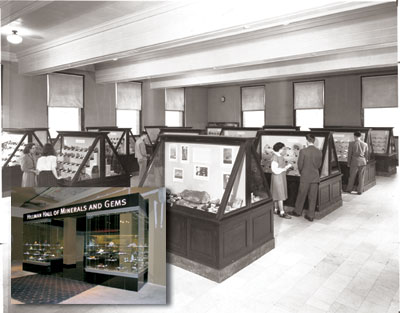 Spring 2007
Spring 2007|
|
The Dazzle of Hillman Hall
Wide-eyed kids and bedazzled adults have been leaving fingerprints on Hillman Hall’s glass cases for more than 25 years now. And that’s a beautiful thing, says Marc Wilson, the collection manager and head of Carnegie Museum of Natural History’s section of minerals, because it shows just how much they’re enjoying the hall’s eye-popping collection of 1,300-plus gems and minerals. “They are so perfect, so ordered, so beautiful. And each is unique,” Wilson says of the hall’s treasures. It’s only natural, then, that these wonders of nature would be so admired. And to gauge which specimens are admired most, Wilson long ago concocted his own unscientific process: “It’s the ‘fingerprint index,’” he says. “We count the fingerprints left on the display glass at the end of a busy day to judge an exhibit’s popularity. The birthstone display has won every time, followed closely by the gold and quartz exhibits.” Marc, his wife and partner-in-minerals Deb Wilson, and numerous volunteers and museum staff have spent plenty of time diligently wiping off the fingerprints. Those glass cases have been out of the public eye for more than 10 months as Hillman Hall of Minerals and Gems has been undergoing an exciting expansion and makeover. In December 2006, the museum unveiled the hall’s beautiful new entrance (right), and the rest of the hall will open early this summer. Soon, visitors will once again be able to “ooh” and “aah” over the hall’s signature pieces: the yellowish-gold Hemimorphite, extracted from a mine pocket in Joplin, Missouri, in 1895 and a gift to Andrew Carnegie by A. L. Means two years later; the “City in the Clouds,” a cluster of tourmaline gemstones with watermelon-colored spikes protruding like skyscrapers; the 2,200-pound glacial nugget of native “float” copper, discovered south of Houghton, Michigan; and the museum’s fantastic, 168-piece collection of minerals that had been locked behind the Iron Curtain, unobtainable, until the fall of communism—the products of “some of the most significant mineral deposits on Earth,” Wilson says. The highlight of the Hillman Hall expansion will be The Wertz Gallery, named in honor of Ronald W. Wertz, longtime president of the Hillman Foundation. Henry Hillman, Marc Wilson, and everyone else close to the museum give Wertz credit for making the hall what it is today. “There isn’t a bigger champion or advocate of Hillman Hall,” Wilson says. “For 35 years, Ron’s energy and vision have helped to develop the collection and make Hillman Hall one of the best in the country.” The Wertz Gallery will be the crowd-pleasing home of gems of all kinds—in their raw form, as cut stones, and set in jewelry. It will also regularly feature traveling exhibits of priceless jewelry and gems. And, of course, the ever-popular birthstone exhibit will be a focal point of the gallery. Marc Wilson will no doubt be ready with his white cloth when the “new” Hillman Hall opens this summer. - - - In 1948, Carnegie Museum of Natural History’s new “Mineral Hall” (above) was the precursor to today’s Hillman Hall of Minerals and Gems. This summer, a new-and-improved Hillman Hall will open to the public, featuring a beautiful new entrance (right), already on view.
|
Also in this issue:
One Hot Topic · West Looks East · Golden Years · Off the Wall …and Into Packed Theaters · Director's Note · NewsWorthy · Now Showing · Face Time: Lareese Hall · Artistic License: Bizarre Beasts · First Person: Video Art, by Douglas Fogle · About Town: Let's Explore · Another Look: The Natural History Docent · Science & Nature: In Search of the Best Visitor Experience
 |
Copyright © 2017 CARNEGIE Magazine. All rights reserved. |

